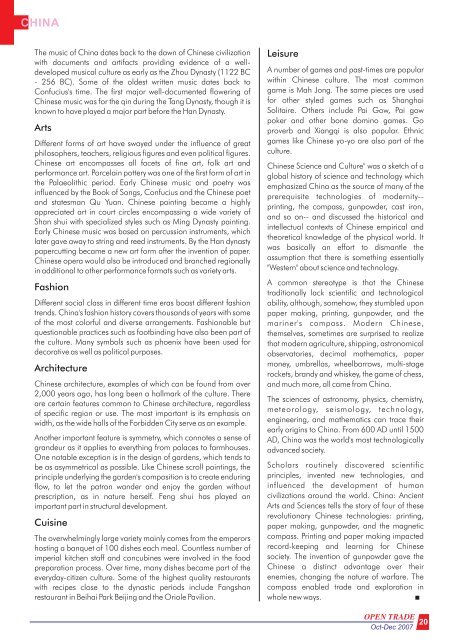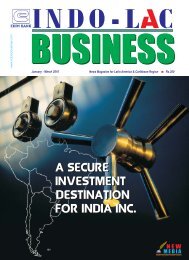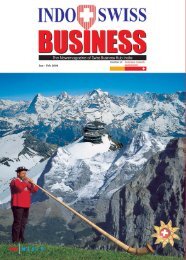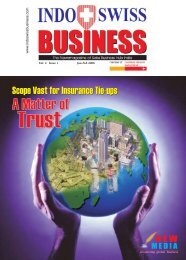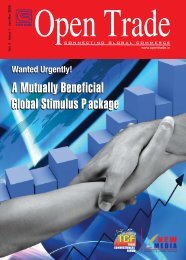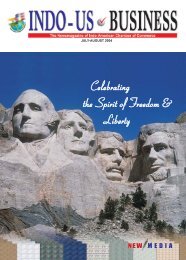pele SciaSction - new media
pele SciaSction - new media
pele SciaSction - new media
You also want an ePaper? Increase the reach of your titles
YUMPU automatically turns print PDFs into web optimized ePapers that Google loves.
CHINA<br />
The music of China dates back to the dawn of Chinese civilization<br />
with documents and artifacts providing evidence of a welldeveloped<br />
musical culture as early as the Zhou Dynasty (1122 BC<br />
- 256 BC). Some of the oldest written music dates back to<br />
Confucius's time. The first major well-documented flowering of<br />
Chinese music was for the qin during the Tang Dynasty, though it is<br />
known to have played a major part before the Han Dynasty.<br />
Arts<br />
Different forms of art have swayed under the influence of great<br />
philosophers, teachers, religious figures and even political figures.<br />
Chinese art encompasses all facets of fine art, folk art and<br />
performance art. Porcelain pottery was one of the first form of art in<br />
the Palaeolithic period. Early Chinese music and poetry was<br />
influenced by the Book of Songs, Confucius and the Chinese poet<br />
and statesman Qu Yuan. Chinese painting became a highly<br />
appreciated art in court circles encompassing a wide variety of<br />
Shan shui with specialized styles such as Ming Dynasty painting.<br />
Early Chinese music was based on percussion instruments, which<br />
later gave away to string and reed instruments. By the Han dynasty<br />
papercutting became a <strong>new</strong> art form after the invention of paper.<br />
Chinese opera would also be introduced and branched regionally<br />
in additional to other performance formats such as variety arts.<br />
Fashion<br />
Different social class in different time eras boast different fashion<br />
trends. China's fashion history covers thousands of years with some<br />
of the most colorful and diverse arrangements. Fashionable but<br />
questionable practices such as footbinding have also been part of<br />
the culture. Many symbols such as phoenix have been used for<br />
decorative as well as political purposes.<br />
Architecture<br />
Chinese architecture, examples of which can be found from over<br />
2,000 years ago, has long been a hallmark of the culture. There<br />
are certain features common to Chinese architecture, regardless<br />
of specific region or use. The most important is its emphasis on<br />
width, as the wide halls of the Forbidden City serve as an example.<br />
Another important feature is symmetry, which connotes a sense of<br />
grandeur as it applies to everything from palaces to farmhouses.<br />
One notable exception is in the design of gardens, which tends to<br />
be as asymmetrical as possible. Like Chinese scroll paintings, the<br />
principle underlying the garden's composition is to create enduring<br />
flow, to let the patron wander and enjoy the garden without<br />
prescription, as in nature herself. Feng shui has played an<br />
important part in structural development.<br />
Cuisine<br />
The overwhelmingly large variety mainly comes from the emperors<br />
hosting a banquet of 100 dishes each meal. Countless number of<br />
imperial kitchen staff and concubines were involved in the food<br />
preparation process. Over time, many dishes became part of the<br />
everyday-citizen culture. Some of the highest quality restaurants<br />
with recipes close to the dynastic periods include Fangshan<br />
restaurant in Beihai Park Beijing and the Oriole Pavilion.<br />
Leisure<br />
A number of games and past-times are popular<br />
within Chinese culture. The most common<br />
game is Mah Jong. The same pieces are used<br />
for other styled games such as Shanghai<br />
Solitaire. Others include Pai Gow, Pai gow<br />
poker and other bone domino games. Go<br />
proverb and Xiangqi is also popular. Ethnic<br />
games like Chinese yo-yo are also part of the<br />
culture.<br />
Chinese Science and Culture" was a sketch of a<br />
global history of science and technology which<br />
emphasized China as the source of many of the<br />
prerequisite technologies of modernity--<br />
printing, the compass, gunpowder, cast iron,<br />
and so on-- and discussed the historical and<br />
intellectual contexts of Chinese empirical and<br />
theoretical knowledge of the physical world. It<br />
was basically an effort to dismantle the<br />
assumption that there is something essentially<br />
"Western" about science and technology.<br />
A common stereotype is that the Chinese<br />
traditionally lack scientific and technological<br />
ability, although, somehow, they stumbled upon<br />
paper making, printing, gunpowder, and the<br />
mariner's compass. Modern Chinese,<br />
themselves, sometimes are surprised to realize<br />
that modern agriculture, shipping, astronomical<br />
observatories, decimal mathematics, paper<br />
money, umbrellas, wheelbarrows, multi-stage<br />
rockets, brandy and whiskey, the game of chess,<br />
and much more, all came from China.<br />
The sciences of astronomy, physics, chemistry,<br />
meteorology, seismology, technology,<br />
engineering, and mathematics can trace their<br />
early origins to China. From 600 AD until 1500<br />
AD, China was the world's most technologically<br />
advanced society.<br />
Scholars routinely discovered scientific<br />
principles, invented <strong>new</strong> technologies, and<br />
influenced the development of human<br />
civilizations around the world. China: Ancient<br />
Arts and Sciences tells the story of four of these<br />
revolutionary Chinese technologies: printing,<br />
paper making, gunpowder, and the magnetic<br />
compass. Printing and paper making impacted<br />
record-keeping and learning for Chinese<br />
society. The invention of gunpowder gave the<br />
Chinese a distinct advantage over their<br />
enemies, changing the nature of warfare. The<br />
compass enabled trade and exploration in<br />
whole <strong>new</strong> ways.<br />
<br />
OPEN TRADE 20<br />
Oct-Dec 2007


